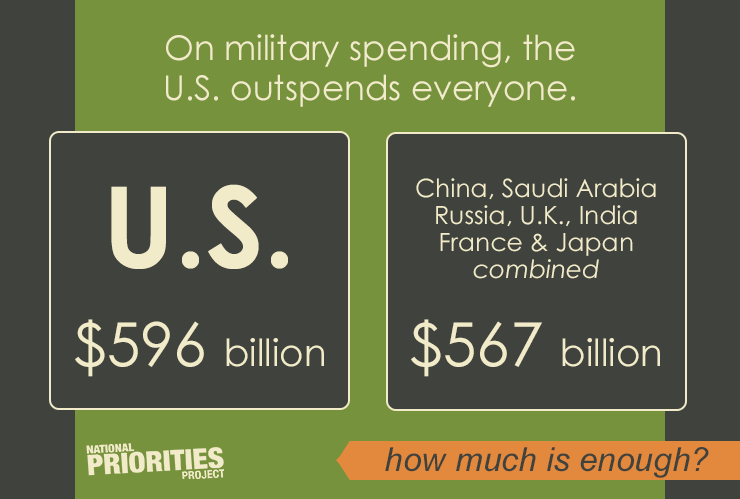
We spend far more on the military than the countries we most fear, while shorting the things that would actually help us compete.
William D. Hartung & Ben Freeman / Defense One
WASHINGTON (February 9, 2020) — As we await the release of thePentagon’s latest budget proposal on Monday, the same foreign policy elites that sold us the Iraq war and the Afghanistan surge are at it again, telling us that more money equals more security. But in this century more spending has made us less safe, not more.
Those who are clamoring for more military money are ignoring the fact that the Pentagon and related work on nuclear warheads at the Department Energy already costs taxpayers nearly three quarters of a trillion dollars every year and that the Pentagon is getting more now than it did during the peaks of the Korean or Vietnam Wars or the Reagan buildup of the 1980s.
The principal culprit for this overspending isn’t the actual threats we face, it’s the threats foreign policy elites imagine. The Pentagon’s misguided National Defense Strategy, for example, never met a threat it couldn’t inflate or a challenge it didn’t see as requiring a military solution.
The first major flaw in the Pentagon’s strategy is its treatment of great power competition with Russia and China, which it describes as the “principal priorities for the department,” requiring “increased and sustained investment” because of its assessment of the magnitude of the threats they pose.
But the United States already substantially outspends both nations on its military, outpacing China by a margin of roughly 2.5 to 1 and Russia by 10 to 1. And unlike those two powers, the United States has numerous capable allies in both Europe and Asia that can help address any challenges they pose to US and global security.

More importantly, the primary challenge posed by Beijing is economic, not military. The best thing the United States can do to address China’s rise is to invest in education and the economy, with a particular focus on investments in science and technology. And we should be seeking areas of potential cooperation with China, like combatting climate change and epidemics of disease — like the coronavirus — not preparing for a military confrontation with a nuclear-armed power that could spark an unprecedented humanitarian catastrophe.
As for Russia, our European allies together spend three times what Moscow devotes to its military, and have economies more than ten times its size. That’s more than enough to address any Russian threat that may arise, allowing the United States to scale back its presence in Europe. The key is to pursue this transition in an atmosphere of respect and mutual consultation rather than via threats and insults, as President Trump has done.
The next priority for the National Defense Strategy is to contain and if necessary confront North Korea and Iran, which it describes as “rogue regimes.” But neither challenge is amenable to a military solution. Tough-minded, realistic negotiations designed to curb their nuclear programs would be a more fruitful approach, as difficult and frustrating as that can be at times. The Trump administration’s abandonment of the Iran nuclear deal was a major setback for Mideast security, and has set the stage for current tensions, which serve no one’s interest.
America’s military-first approach to fighting terrorism has also done more harm than good, sowing chaos, backing corrupt regimes in Iraq and Afghanistan, setting the stage for the rise of ISIS, and failing to weaken the Taliban.
As Brown University’s Costs of War Project has documented, these strategic failures have come at a high price in lives and treasure, with trillions of dollars wasted, thousands of US military personnel killed, and hundreds of thousands of US veterans left with physical or psychological injuries. A strategy that forgoes military occupations and large-scale counterinsurgency would allow for a reduction in the size of the US military, a key to budgetary savings.
Fortunately, we don’t have to blindly follow the formula set out in the National Defense Strategy, which wastes taxpayer dollars without increasing our security. The Center for International Policy’s Sustainable Defense Task Force — a group of former White House, Congressional, and Pentagon budget specialists joined by non-governmental experts from across the political spectrum — has crafted an alternative plan that would save at least $1.2 trillion in scarce tax dollars over the next decade while providing a greater measure of security.
Whether it’s this plan or one of the many others that have been put forward to reduce wasteful spending at the Pentagon, it’s long past time for Congress and the public to reject yet another bloated budget request for the department. We can’t sit idly by as the Pentagon budget soars and expect that doing so will somehow make America safer.
Related:
• SecDef: Expect ‘Trimming, Reducing, Some Eliminations’ in 2021 Budget
• Why Does the US Spend So Much on Defense?
• The Two Things Every Senior Pentagon Leader Is Worried About
William D. Hartung is the director of the Arms and Security Project at the Center for International Policy, a senior adviser to the Center’s Security Assistance Monitor, and a co-director of the Center’s Sustainable Defense Task Force. Ben Freeman is the director of the Foreign Influence Transparency Initiative at the Center for International Policy. He also co-directs the Center’s Sustainable Defense Task Force.
Posted in accordance with Title 17, Section 107, US Code, for noncommercial, educational purposes.